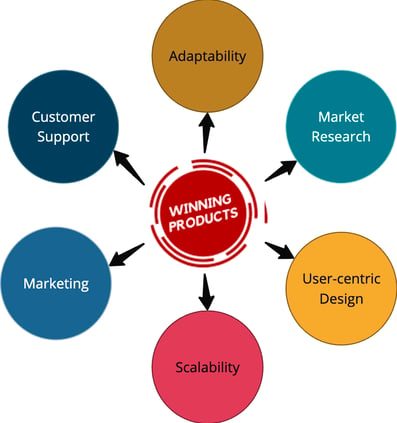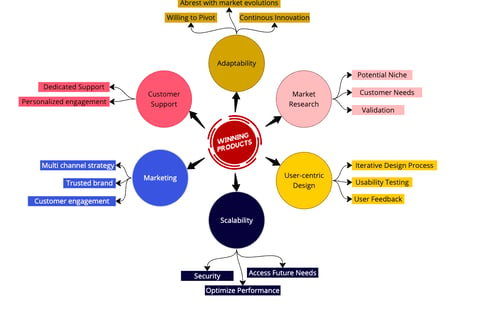Building a Sustaining E-Commerce Product: A Case Study
This case study explores the journey of building a sustaining e-commerce product, examining key milestones, challenges, and strategies employed to ensure long-term viability.
Kumar Vivek
12/26/20234 min read
In the ever-evolving landscape of e-commerce, the ability to create and maintain a successful product sits on a sweet spot between strategic blend of innovation, market understanding, and adaptability. This case study explores the journey of building a sustaining e-commerce product, examining key milestones, challenges, and strategies employed to ensure long-term viability.
E-commerce or electronic commerce is a digital shop comprising of sale and purcase of physical and non-physical good. It can be anything accesible via internet - products on amazon, hiring a cleaning services or learning languages through app.
According to a report published at Research and Markets :
The global e-commerce market size reached US$ 16.6 Trillion in 2022 and expected to reach US$ 70.9 Trillion by 2028, exhibiting a CAGR of 27.38% during 2022-2028.
E-commerce is usually classified based on numerous business models, which include Business to Business (B2B)- ex. Salesforce, Business to Customer (B2C)- ex. Amazon, Customer to Business (C2B)-ex. Youtubers/Bloggers and Customer to Customer (C2C)- ex. eBay.
There are minimal conditions for market entry and exit, almost all of customer segments are quite crowded and demand of consumers is ever evolving. So how do you introduce a new product, stay relevant and competitive, and earn profit and love from customers.
Let's explore potential steps that can be essential to a winning product- loved by customers and emulated by industry.
6 components for a winning product.
Market Research and Validation
Innovation needs to be part of your culture. Customers are transforming faster than we are, and if we don’t catch up, we’re in trouble - Ian Schafer (CEO and Founder of Deep Focus)
The foundation of any successful e-commerce venture lies in a thorough understanding of the market. The most important question to be answered here are : WHY this product and WHAT is the product.
Our case study begins with extensive market research to identify potential niches, consumer needs, and emerging trends. This phase involves analyzing competitors, monitoring market trends, conducting surveys, and gathering feedback from potential users.
An important step at this point is marrying the product vision with customer expectations. Validation of the product idea is crucial to avoid investing resources in an unviable concept. Through prototypes, landing pages, or MVPs (Minimum Viable Products), we gauged user interest and adjusted our product based on early feedback.
User-Centric Design
Good design is good business - Thomas Watson Jr. (Former CEO of IBM)
HOW this Product is built - thats our focus for this part.
Modern day customers are looking for clean, intitutive and fast interface in an e-commerce product. In an research by Design Value Index, design-driven products can outperform their competitors by as much as 228%.
Creating an intuitive and visually appealing user interface is essential for attracting and retaining customers. In our case, we prioritized user-centric design principles, ensuring that the product was not only functional but also aesthetically pleasing.
This involved iterative design processes, usability testing, and incorporating user feedback to enhance the overall user experience. By focusing on simplicity, navigation, and responsive design, we aimed to create a seamless and enjoyable shopping experience for our customers.
Scalable Infrastructure and Technology:
You can focus on things that are barriers or you can focus on scaling the wall or redefining the problem - Tim Cook ( CEO of Apple)
As an e-commerce platform grows, scalability becomes a critical factor in sustaining success. In a blog article published by gibraltar solutions, they emphasized how to build an scalable IT infrastructure and why its imperative to stay competitive in the market.
Our case study emphasizes the importance of investing in a robust and scalable infrastructure from the outset. This includes selecting the right e-commerce platform, implementing a reliable hosting solution, and optimizing digital performance.
Additionally, integrating advanced technologies such as AI-driven personalization, machine learning for recommendation engines, and secure payment gateways contributed to the overall efficiency and competitiveness of the product.
Marketing and Branding:
A brand is no longer what we tell the consumer it is—it is what consumers tell each other it is - Scott Cook ( CEO and founder of Intuit)
Building brand awareness is essential for the sustained success of an e-commerce product. Our case study highlights the use of a multi-channel marketing strategy, including social media, content marketing, influencer collaborations, and search engine optimization (SEO).
By consistently communicating the brand's values, unique selling propositions, and engaging with the target audience, we will able to create a strong brand presence in the market.
Customer Support and Engagement:
We see our customers as invited guests to a party, and we are the hosts. It’s our job every day to make every important aspect of the customer experience a little bit better. - Jeff Bezos ( Former CEO of Amazon)
Providing exceptional customer support is crucial for building trust and retaining customers. In our case, a dedicated customer support team was established to address inquiries, resolve issues, and gather valuable feedback. Proactive engagement through newsletters, personalized promotions, and loyalty programs further strengthened the relationship with our customer base.
Adaptability and Innovation:
Change almost never fails because it’s too early. It almost always fails because it’s too late. - Seth Godin ( Author of the book This is Marketing)
The e-commerce landscape is ever-evolving, and adaptability is key to long-term success. Our case study underscores the importance of continuous innovation, staying abreast of industry trends, and being willing to pivot when necessary.
By monitoring market changes, technological advancements, and customer preferences, our team was able to introduce new features, expand product offerings, and adapt the business model to stay competitive.
Conclusion
Building and sustaining a successful e-commerce product is a dynamic and challenging process that requires a combination of strategic planning, user-centric design, and adaptability.
This case study outlines the key factors that contributed to the success of our e-commerce venture, emphasizing the importance of market research, scalable technology, effective marketing, customer engagement, and a commitment to innovation. Below is short visual summary of key steps and takeaway points.
Visula summary of vital components for the e-commerce product.
By implementing these strategies, businesses can increase their chances of creating a product that not only thrives in the short term but also maintains long-term sustainability in the ever-evolving e-commerce landscape.
Note: All stakeholders should be involved at all stages of product development. A product is loved only when all vital components building it are working in sync.




